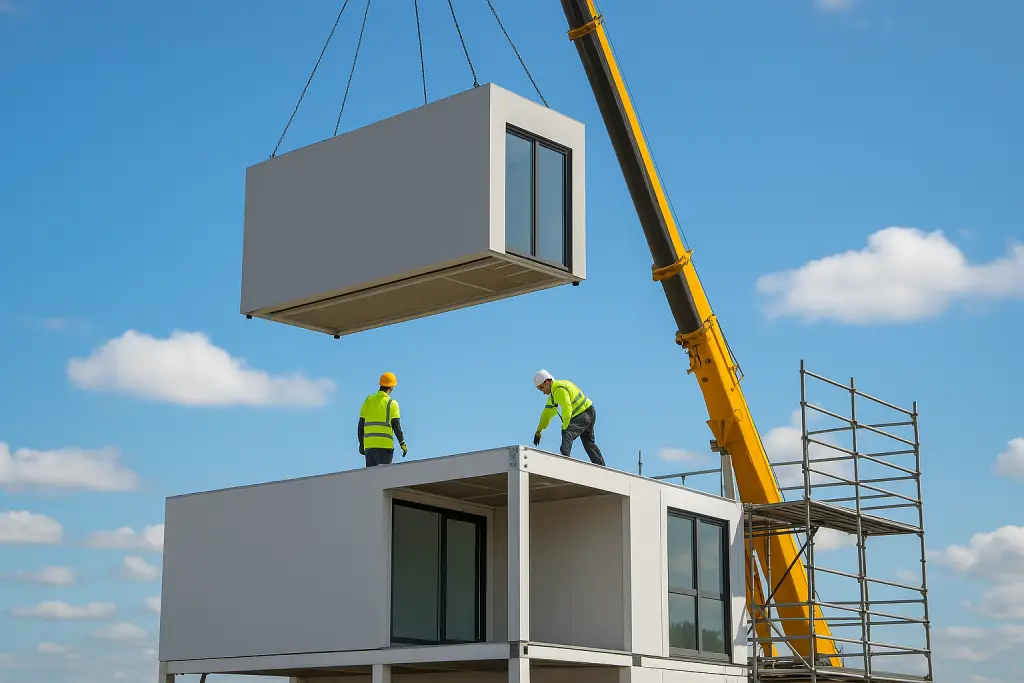History and Evolution of Industrialized Construction
When we think of industrialized construction, we usually associate it with concepts like modernity, technological innovation, quality, and efficiency. However, this construction method has a longer history than many imagine.
Origins of Industrialized Construction
The emergence of industrialized construction was not coincidental but rather a practical response to specific needs, particularly evident at the end of the 18th century with the advent of the First Industrial Revolution. Urban expansion and the establishment of new settlements, especially in the United States, provided an ideal context for experimenting with innovative building techniques. In Chicago, for example, the “Balloon Frame” system emerged, based on prefabricated wooden structures.
Wood as the Initial Resource
The “Balloon Frame” was a highly popular method in the United States during this initial phase of construction industrialization. While today we associate Industry 4.0 with materials like prefabricated concrete, wood was crucial in the beginning due to its availability and ease of handling. This method involved manufacturing modular structures in external workshops, then quickly assembling them on-site.
Simultaneously, major European powers began constructing prefabricated structures for their colonies, addressing the urgent need for housing that was sturdier and more comfortable than the provisional tents initially used. These buildings were manufactured in Europe and transported by sea, requiring them to be lightweight, easy to assemble, stackable to save space, and resource-efficient in their production. Notable examples include the “iron houses,” wooden prefabricated homes covered with metal sheets, used in British colonies in Australia and Africa.
Glass and Steel as Protagonists
In industrialized construction, the combination of glass and steel became essential. A milestone was the Crystal Palace, constructed for the Great Exhibition of 1851 in London. This building, featuring metal structures and large glass panels, set a precedent in large-scale prefabricated construction, completed in only six months.
Momentum and Development during the 19th and 20th Centuries
Throughout the late 19th century and into the 20th, industrialized construction evolved significantly. After the devastating Chicago fire in 1871, the high flammability of wooden structures prompted the search for alternatives, highlighting the use of steel and prefabricated concrete. Nevertheless, wood remained popular, exemplified by the “Kit houses” sold through catalogs by Sears Roebuck & Co., considered precursors of today’s Ikea concept.
Innovation Before and After World War II
In the first half of the 20th century, prefabricated concrete gained prominence, significantly advanced by Marie-Eugene Freyssinet, who designed large-scale structures like the parabolic hangars constructed between 1921 and 1923 in France. During this period, the Bauhaus and architects such as Walter Gropius and Le Corbusier also notably contributed to the technical and conceptual advancement of industrialized construction.
World War II further accelerated these techniques due to the urgent need for rapid and economical reconstruction in devastated cities. In this context, Jean Prouvé stood out with projects like the “25 Maisons Standard Metropole” in France, proving that industrialized housing could be quick, economical, and efficient. Similarly, Americans Charles and Ray Eames constructed the iconic “Case Study House 8” in Los Angeles in just 90 hours.
Modular Buildings and Progress Towards the Future
Another 20th-century landmark was Moshe Safdie’s “Habitat 67,” built for the Montreal Olympic Games in 1967. This residential complex challenged negative stereotypes about the aesthetics of prefabricated concrete construction, creating a new perception of modular architectural beauty.
Industrialized Construction in the 21st Century
Today, initial objectives of speed and economy blend with a commitment to sustainability and technological advancement. The so-called Construction 4.0 demands comprehensive planning from the initial conception, involving all stakeholders in the building process. Optimizing resources, both material and human, remains essential for industrialized construction to continue being an efficient and profitable sector in the current context.
